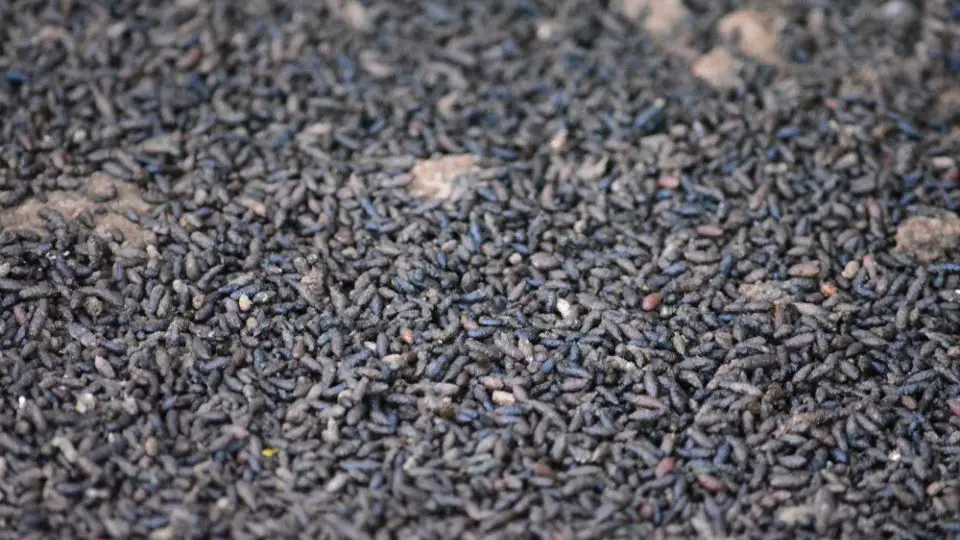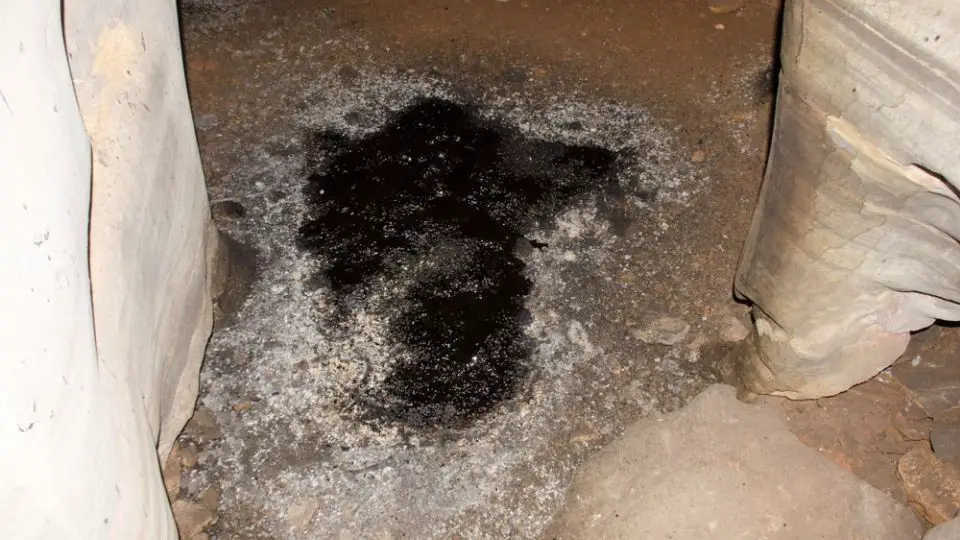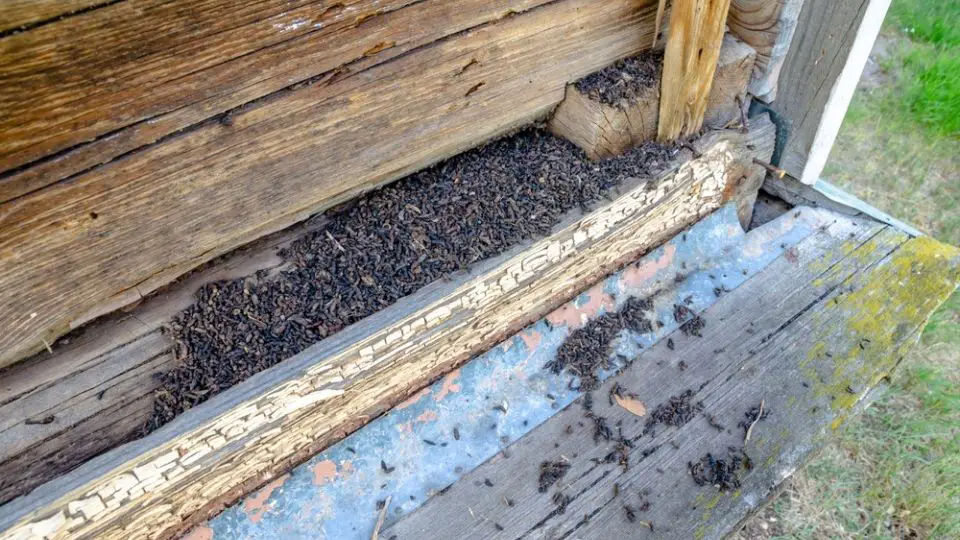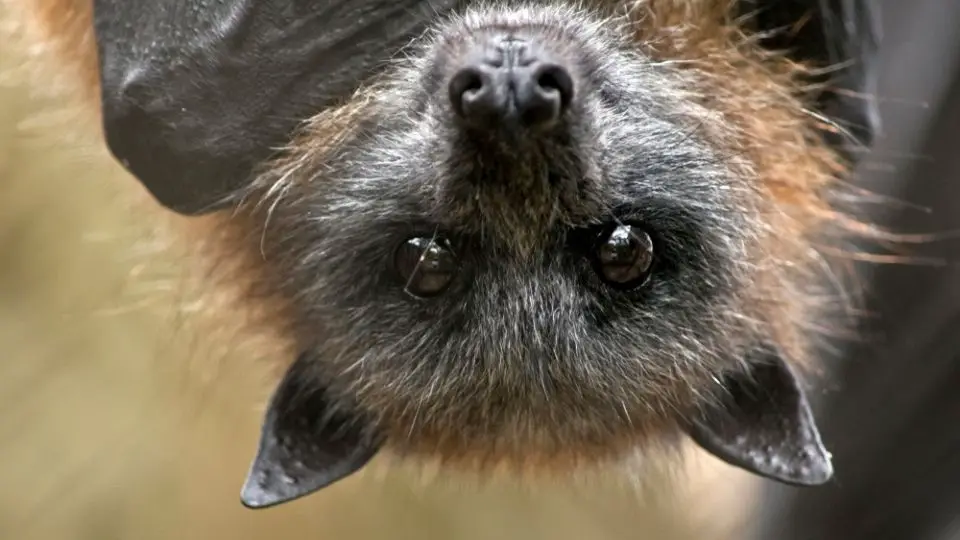Bat poop, also known as "guano", takes the form of tiny, black, and elongated pellets. Unlike mouse poop, they crumble under pressure and may contain remnants of insect exoskeletons. Fascinatingly enough, they also glimmer in the sunlight.
Let’s look into the different characteristics of bat guano, so you can correctly identify it in your home or yard.
Table of Contents
How to Identify Bat Poop
Bat droppings are sometimes referred to as guano. They are typically cylindrical in shape and dark brown to black, depending on the bat species.
Guano looks like black grains of rice, measuring about 4 and 8 mm from end to end. This is approximately the same size as mouse droppings. However, bat poop has a softer texture compared to mouse poop.
Old guano can turn brittle, gray, and dusty. When disturbed, the fecal matter can crumble. This is because bats are insectivores—their poop contains the remains of exoskeletons from the bugs they’ve eaten.
You might also notice small, shiny objects in bat droppings. These fragments of beetle wings or chitinous insect bits pass through the bat’s digestive tract.

How to Tell the Difference Between Bat and Mouse Poop
When simply observing a single sample of fecal matter, the difference between bat and mouse poop isn’t immediately clear. However, in the wild, three distinct indicators may be used to distinguish bat poop vs mice poop. These are:
- Poop density
- Poop texture
- Poop smell
Mice tend to defecate more frequently, leaving small, individual droppings around the places they tread. They aren’t picky over where they poop, so you can encounter mice poop scattered all over a room or shed.
Meanwhile, adult and baby bats will relieve themselves in one area—usually underneath a roosting site. This could be an attic, cave, or tree hollow. Because of this habit, you’re likely to find large piles or mounds of bat poop in a single, centralized location.
Another way to tell them apart in fact is by doing a texture test. Mouse poop is pasty when fresh and becomes firmer as time passes. Bat poop, on the other hand, is crumbly when fresh and stays brittle for good. This difference is due to the diet of each creature—bats eat mostly insects, while mice are omnivores.
Lastly, the smell test. Mouse poop smells stale and musty. However, bat droppings tend to be quite pungent. Many people claim bat poop smells like ammonia, especially during damp weather. If your house smells putrid, you’re likely housing a fairly sizeable bat colony and will need a wildlife removal specialist to deal with the infestation.

Are Bat Droppings Harmful to Humans?
There’s moderate risk involved when humans are exposed to bat droppings. This is largely due to their brittle nature—if the fecal matter is disturbed, it can release spores into the air. These spores are harmful if inhaled by people with weakened immune systems.
Histoplasma is the most prevalent respiratory infection caused by inhaling these spores. This illness is caused by the histoplasmosis fungus—an organism that thrives in the soil where there’s an abundance of bat feces. In uncommon cases, it can make its way to the human body during clean-up and demolition.
The symptoms are often mild and mimic those of the flu, such as fever, chest pain, and coughing. In extreme cases, however, histoplasmosis can lead to long-term lung infection and even death. And unfortunately, about 8% of children and 5% of adults diagnosed with this condition eventually succumb to it.
What Happens if You Touch Bat Poop?
Touching bat poop is a health hazard. If you manage to touch and scatter brittle dust guano, there’s a possibility that you’ll get infected with a respiratory disease called histoplasmosis.
That said, histoplasmosis only occurs in certain regions of the world, namely around the Ohio and Mississippi River valleys in the US and some parts of Asia, Australia, Africa, and Central America. If you live in areas unmentioned, the chances of the infection occurring to you are relatively slim.
If you need to dispose of bat poop, wear gloves and a mask while handling the guano. Afterward, wash your hands very well with soap and water.
Is Bat Poop Toxic to Dogs?
Unfortunately for our furry friends, histoplasmosis can also be transmitted to dogs. This can cause chronic coughing and labored breathing in some canines. Gastrointestinal problems can also occur, particularly diarrhea and vomiting.

What to Do if You Identify Bat Poop in or Around Your House?
If you want to take care of the problem yourself, here are the steps you should take to deal with these problematic pests:
- Seal any gaps and cracks on your home’s wall, windows, and doors.
- These are potential points of entry for bats.
- Trap and remove any bats you find roosting in your home.
- Bats are a protected species, so be sure to check your state’s regulations before relocating.
- Wear gloves, a mask that can filter 1 mµ, and protective, disposable clothing
- Do so before entering any crawl space or bat poop-infested area.
- Spray water on the bat poop to prevent spores from becoming airborne.
- Use a vacuum or shovel to remove the bat guano and deposit it in a plastic bag.
- Afterward, seal the trash bin tight and dispose of it outside.
- Perform a final scrub-down of the affected area with a bleach and water solution.
The presence of bat excrement can signal an infestation in your home. If you find bat guano, it’s best to contact a bat removal specialist to rectify the situation.

